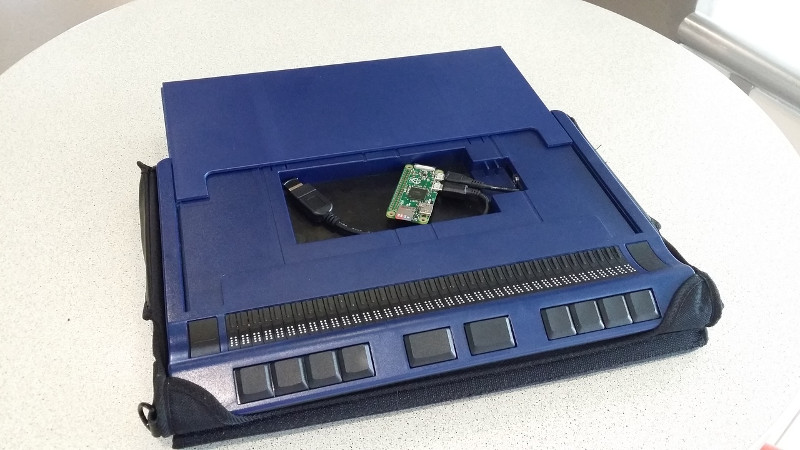Our recent coverage of a Raspberry Pi Zero inside the official Pi keyboard prompted a reader to point us to another far more unusual keyboard with a Pi Zero inside it. It may be a couple of years old, but [Mario Lang]’s Braille keyboard and display with built-in Pi is still an interesting project and one that should give sighted readers who have not encountered a Braille display an introduction to the technology.
The model in question is a Handy Tech Active Star 40, which seems to have been designed to have a laptop sit on top of it. A laptop was not the limit of its capabilities, because it also has a compartment with a handy USB connector that was intended to take a smartphone and thus makes a perfect receptacle for a Pi Zero. Sadly the larger boards are a little tall with their connectors.
If this hack were preformed today he would undoubtedly have used a Pi Zero W, but since the Zero he had did not possess WiFi he relied upon a Bluetooth dongle for connectivity to the outside world. The BRLTTY screen reader provides a Braille interface to the Linux console, resulting in an all-in-one Braille computer in a very compact form factor.
This is one portable Braille computer, but it’s by no means the only one we’ve seen. Thanks [Simon Kainz] for the tip, and here’s a nod to the Pi keyboard that inspired him.
















It’s this kind of thing that reminds me what we take for granted.
Awesome project, didn’t knew this tech existed
Years ago the base chaplain on an Army base I lived on had a legally blind assistant who used a modified IBM Selectric typewriter that had a braille “display” that she could type in a line of text and “read” before it committed what she typed onto the paper.
I never understood how someone can differentiate the tiny bumps into a full alphabet with just the tips of their fingers. She could run her fingers across the “display” and read the entire line in one quick sweep.
Never have i understood how someone could glance at some squiggly lines and have a dead person’s thoughts ring in their head.
I really want to see a tear down of one of those braille elements now. I watched a few of the companies videos on youtube and the devices are fascinating! While the greater good of accessibility devices is their real purpose, I must admit I’m mostly just fascinated by how cool they end up.
I enjoy seeing the braille pads at the drive through ATM at the bank.
Those are for passengers in right hand drive cars.
(assuming you are in a left hand drive country)
B^)
…or the passengers that plan on that, and sit in the driver rear seat on bank runs.
an even simpler explanation, though not as fun, is that the same ATMs that they put at walk-up locations are also used in drive-throughs and it would be an extra cost to maintain two separate versions so both versions get all the same keypads, stickers, labels and artwork, etc.
Oh Dominic, you and your crazy schemes!